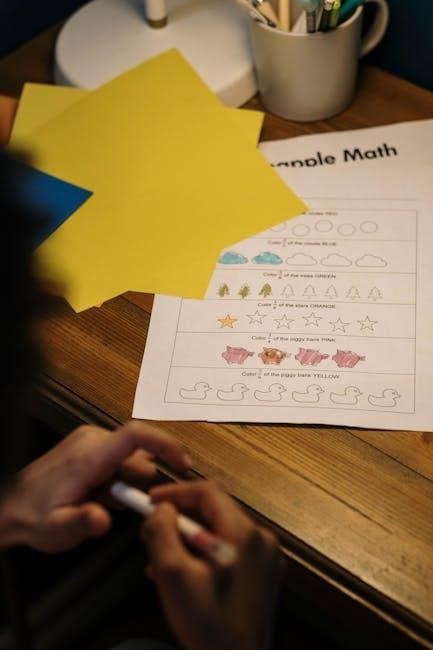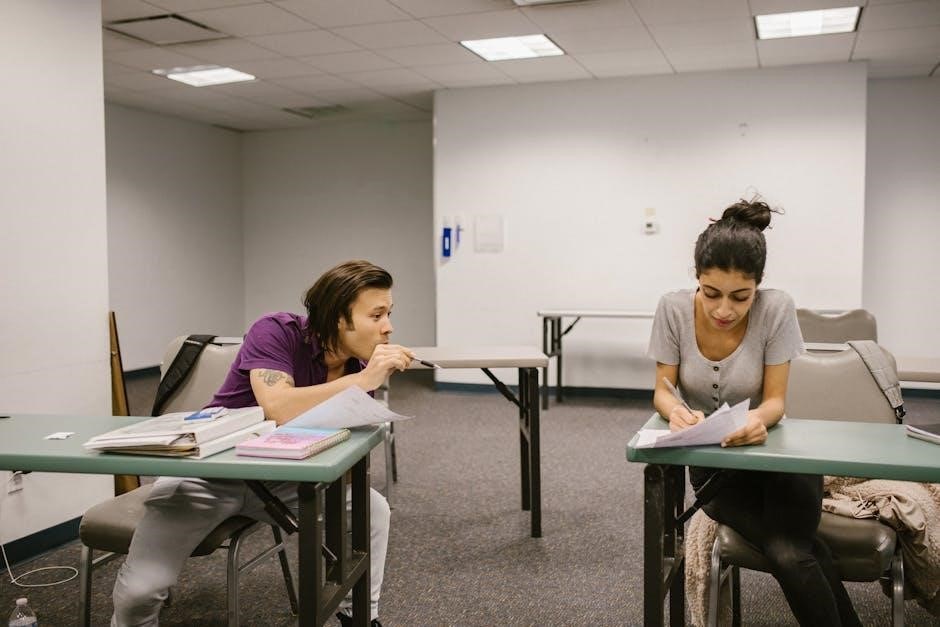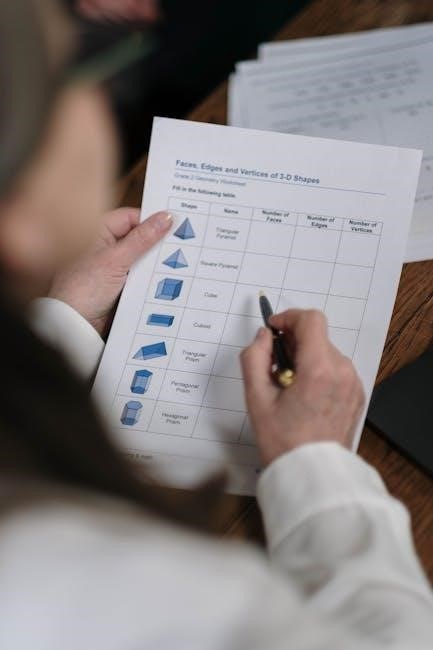Plural nouns represent more than one person‚ place‚ or thing. Understanding when to add ‘s’ or ‘es’ is crucial for correct spelling in English. This guide explores rules‚ exceptions‚ and practical exercises to master plural forms effectively.
What Are Plural Nouns?

Plural nouns are words that represent more than one person‚ place‚ or thing. They are essential in communication to indicate quantity. For example‚ “cat” becomes “cats‚” and “book” becomes “books.” Adding ‘s’ or ‘es’ is the most common way to form plurals in English. Words like “kids‚” “pets‚” and “pictures” use ‘s‚’ while “shells” and “boxes” use ‘es.’ This rule applies to most nouns‚ but exceptions exist‚ such as irregular plurals like “children” or “feet.” Understanding plural nouns is vital for clear and accurate writing and speech. Worksheets and PDF resources‚ like those found on https://www.allthingsgrammar.com‚ provide exercises to practice these rules. Mastering plural forms helps in forming correct sentences and avoids confusion in meaning. Regular practice with quizzes and interactive activities ensures proficiency in using ‘s’ or ‘es’ correctly. This foundation is crucial for further learning in grammar and spelling.
Why Is Understanding ‘s or ‘es’ Important?
Mastering the use of ‘s’ or ‘es’ in plural nouns is essential for clear and accurate communication in English. Proper use ensures that sentences are grammatically correct and convey the intended meaning without ambiguity. Incorrect plurals can confuse readers or listeners‚ potentially altering the message. For instance‚ “cats” (adding ‘s’) and “boxes” (adding ‘es’) demonstrate how these endings differentiate singular and plural forms. Understanding these rules is particularly vital for learners‚ as it builds a strong foundation in grammar and spelling. Worksheets and PDF resources‚ such as those found at https://www.allthingsgrammar.com‚ offer practical exercises to reinforce these concepts. Without this knowledge‚ even simple sentences can become unclear. For example‚ “sheeps” (incorrect) versus “sheep” (correct) highlights the importance of understanding irregular plurals. Regular practice with quizzes and interactive activities helps solidify these skills‚ making writing and speaking more precise and professional.

Basic Rules for Adding ‘s’ or ‘es’
Add ‘s’ to most nouns to form plurals‚ like “cats” or “books.” Use ‘es’ for words ending in ‘s‚’ ‘ss‚’ ‘sh‚’ ‘ch‚’ ‘tch‚’ or ‘x‚’ such as “buses” or “boxes.” Practice with worksheets from https://www.allthingsgrammar;com.
When to Add ‘s’ to Nouns
Adding ‘s’ is the most common way to form plural nouns. For regular nouns‚ simply attach ‘s’ to the end‚ such as “cats” or “dogs.” This rule applies to most singular nouns‚ making it straightforward for everyday use. For example‚ “book” becomes “books‚” and “chair” becomes “chairs.” This simple method works for the majority of nouns in English‚ providing a clear and consistent way to indicate plurality. By practicing with worksheets from resources like https://www.allthingsgrammar.com‚ learners can master this fundamental grammar rule quickly and efficiently. Regular practice helps reinforce the habit of correctly adding ‘s’ to form plural nouns‚ ensuring clear and accurate communication in writing and speech.

When to Add ‘es’ to Nouns
The ‘es’ ending is used to form plural nouns in specific cases. Add ‘es’ to nouns ending in ‘s‚’ ‘ss‚’ ‘sh‚’ ‘ch‚’ ‘tch‚’ or ‘x.’ For example‚ “bus” becomes “buses‚” and “box” becomes “boxes.” This rule ensures proper pronunciation and clarity. Words like “church” become “churches‚” and “match” becomes “matches.” The ‘es’ ending is also used for nouns ending in ‘y’ when the ‘y’ is preceded by a consonant‚ such as “city” becoming “cities.” This rule helps maintain the correct sound and spelling of plural forms. For more practice‚ worksheets like those found at https://www.allthingsgrammar.com provide exercises to master this grammar rule. By understanding when to add ‘es‚’ learners can improve their spelling accuracy and communication skills. Regular practice with these rules will make forming plural nouns second nature. This section focuses solely on the ‘es’ rule‚ providing a clear guide for its application.
Quick Tips for Remembering the Rules
Mastering when to add ‘s’ or ‘es’ can be made easier with a few simple tips. First‚ memorize the endings that require ‘es’: ‘s‚’ ‘ss‚’ ‘sh‚’ ‘ch‚’ ‘tch‚’ and ‘x.’ For example‚ words like “bus” become “buses” and “church” becomes “churches.” Next‚ practice regularly using worksheets or online tools like those found at https://www.allthingsgrammar.com. Visualize the word endings and associate them with the correct plural form. Use mnemonics‚ such as the phrase “Six Sneaky Sounds” to remember the ‘es’ endings. Additionally‚ focus on nouns ending in ‘y’ preceded by a consonant‚ like “city” becoming “cities.” Test your knowledge with quizzes to identify weak areas. Lastly‚ apply these rules consistently in writing and speaking to build confidence. By following these tips‚ learners can grasp the ‘s’ or ‘es’ rules effectively and improve their grammar skills. Regular practice and repetition are key to long-term understanding and mastery of plural noun formation.

Exceptions to the ‘s’ or ‘es’ Rule
Exceptions to the ‘s’ or ‘es’ rule include irregular nouns and foreign words. These often have unique plural forms that must be memorized for accurate usage in writing and speech.

Irregular Plural Nouns
Irregular plural nouns do not follow the standard ‘s’ or ‘es’ rules. Words like child become children‚ and tooth becomes teeth. Some nouns‚ such as deer or fish‚ remain the same in plural form.
- Examples of irregular plurals:
- man → men
- woman → women
- foot → feet
- mouse → mice
- Why irregular plurals are tricky: They often originate from Old English or other languages‚ making their plural forms unpredictable.
- Tip: Memorization is key‚ as irregular plurals don’t follow a consistent pattern.
Practicing with worksheets can help learners master these unique forms and improve their spelling skills.
Nouns Ending in ‘y’
Nouns ending in ‘y’ often require special attention when forming plurals. The general rule is to change the ‘y’ to ‘ies’ if it follows a consonant. For example‚ city becomes cities‚ and baby becomes babies.
- Plural formation rules for ‘y’:
- Consonant before ‘y’: Change ‘y’ to ‘ies.’
- Example: city → cities
- Vowel before ‘y’: Simply add ‘s.’
- Example: alley → alleys
- Consonant before ‘y’: Change ‘y’ to ‘ies.’
- Exceptions: Some nouns ending in ‘y’ have irregular plural forms‚ such as silly → sillies.
- Practice tip: Worksheets with exercises on ‘y’ endings can help reinforce these rules and exceptions.
Understanding these patterns ensures correct pluralization and enhances overall grammar skills;
Foreign Words and Their Plural Forms
Foreign words often retain their original plural forms when incorporated into English. For example‚ Latin-derived words like cactus become cacti‚ and Greek words like crisis become crises. Similarly‚ Italian words like spaghetti remain spaghetti in plural form.
- Latin plurals:
- Cactus → cacti
- Alumnus → alumni
- Greek plurals:
- Crisis → crises
- Neurosis → neuroses
- Italian plurals:
- Pasta → pasta
- Photocopy → photocopies (adapted to English rules)

Some foreign words adapt to English plural rules by adding ‘s’ or ‘es.’ For instance‚ café becomes cafés‚ and buffalo becomes buffaloes. Understanding these variations is essential for accurate usage in writing and speech. Worksheets and exercises can help master these unique plural forms.

Practice Exercises
Engage in targeted exercises to master the use of ‘s’ and ‘es’ in plural nouns. Worksheets and quizzes provide hands-on practice‚ ensuring learners can apply the rules confidently in various contexts.
- Fill-in-the-blank activities
- Sentence-writing exercises
- Multiple-choice tests
Regular practice helps reinforce grammar skills and improves accuracy in forming plural nouns.
Worksheets for ‘s’ or ‘es’ Practice
Quizzes to Test Your Knowledge
Interactive Activities for Better Learning
Interactive activities are a fun and engaging way to practice adding ‘s’ or ‘es’ to nouns. Online exercises‚ such as drag-and-drop games‚ allow learners to test their knowledge in an immersive environment. For example‚ users can drag the correct ending (‘s’ or ‘es’) to complete plural forms like “cat” or “bus.” Many websites offer these activities‚ making learning feel less like a chore.

- Matching games: Pair singular nouns with their correct plural forms.
- Interactive quizzes: Identify the right ending for each word.
- Word-building exercises: Add ‘s’ or ‘es’ to words ending in specific sounds.
These activities often include immediate feedback‚ helping learners understand their mistakes. Tools like interactive whiteboard activities for classrooms or flashcard apps for on-the-go practice are also available. They make learning dynamic and accessible. By combining practice with entertainment‚ interactive activities ensure a deeper understanding of plural noun rules. Start exploring these resources today to enhance your learning experience!

Resources for Learning
Enhance your understanding with recommended worksheets and PDFs. Visit AllThingsGrammar for free printable quizzes. Explore EasyTeaching for additional resources and practice materials. Perfect for both beginners and advanced learners!
Recommended Worksheets and PDFs
For effective practice‚ explore high-quality worksheets and PDFs designed to help you master the rules of adding ‘s’ or ‘es’. Websites like AllThingsGrammar and EasyTeaching offer free‚ printable resources. These materials include exercises‚ quizzes‚ and activities to reinforce your understanding of plural noun formation. Many worksheets focus on common rules‚ such as adding ‘s’ to most nouns and ‘es’ to words ending in ‘s‚’ ‘ss‚’ ‘sh‚’ ‘ch‚’ ‘tch‚’ or ‘x.’ They also cover irregular plural nouns and exceptions‚ providing comprehensive practice. Interactive PDFs often feature fill-in-the-blank exercises‚ multiple-choice questions‚ and word lists for hands-on learning. Additionally‚ some resources include answer keys or solutions‚ allowing you to track your progress and identify areas for improvement. Download and print these PDFs to enjoy offline practice‚ making learning convenient and accessible. Whether you’re a student or educator‚ these worksheets are invaluable for improving your skills in forming plural nouns correctly.
Online Tools for Practicing ‘s’ or ‘es’
Enhance your learning experience with online tools designed to practice adding ‘s’ or ‘es’ to nouns. Websites like AllThingsGrammar and EasyTeaching offer interactive exercises‚ quizzes‚ and games to make learning engaging. These tools provide instant feedback‚ helping you identify and correct mistakes. Many platforms feature sortable lists of words‚ where you can practice forming plurals by adding the correct ending. Some tools also include timed quizzes to test your speed and accuracy. Additionally‚ interactive PDFs and worksheets are available for download‚ combining online convenience with offline practice. These resources are ideal for learners of all levels‚ from beginners to advanced students. By using these tools regularly‚ you can build confidence in forming plural nouns and master the rules of adding ‘s’ or ‘es’ effectively. They are a great supplement to traditional learning methods and can be accessed anytime‚ anywhere‚ making them a versatile choice for improving your grammar skills.
Additional Reading Materials
To further enhance your understanding of plural nouns and the proper use of ‘s’ or ‘es’‚ there are numerous additional reading materials available. Grammar textbooks like Warriner’s English Grammar and Composition and The Elements of Style provide in-depth explanations and examples. E-books and online guides‚ such as those found on Grammarly Blog and English Central‚ offer comprehensive lessons and exercises. Many educational websites feature downloadable PDF guides specifically focused on pluralization rules. These resources often include detailed charts‚ verb lists‚ and practice exercises to help solidify your understanding. Additionally‚ scholarly articles and educational forums discuss common mistakes and exceptions‚ offering valuable insights. By exploring these materials‚ you can gain a deeper grasp of when to use ‘s’ or ‘es’ and master the nuances of plural nouns. These resources are essential for both learners and educators seeking to improve their grammar skills effectively.
Mastery of plural nouns and proper use of ‘s’ or ‘es’ is essential for clear communication. Regular practice with worksheets and exercises ensures confidence and accuracy in grammar applications.
Mastering plural nouns and understanding when to use ‘s’ or ‘es’ is fundamental for proper grammar. Regular nouns typically follow simple rules: add ‘s’ for most‚ and ‘es’ for nouns ending in ‘o‚’ ‘s‚’ ‘z‚’ ‘x‚’ or ‘sh.’ Irregular nouns‚ such as ‘children’ or ‘feet‚’ require memorization. Nouns ending in ‘y’ often change to ‘ies’ in plural form. Foreign words may have unique pluralization rules. Practice with worksheets and quizzes helps reinforce these concepts. Resources like PDF guides and online tools provide additional support for learning. Consistent practice ensures confidence and accuracy in using ‘s’ or ‘es’ correctly. Understanding these rules enhances communication and writing skills‚ making it essential to dedicate time to mastering them.
Encouragement for Further Practice
Consistent practice is key to mastering the use of ‘s’ or ‘es’ in plural nouns. Don’t hesitate to explore various worksheets and quizzes to sharpen your skills. Interactive activities and online tools can make learning engaging and fun. Setting aside time each day‚ even for a few minutes‚ will help solidify these grammar rules. Remember‚ practice builds confidence and accuracy. The more you engage with exercises‚ the more comfortable you’ll become in using ‘s’ or ‘es’ correctly. Mistakes are part of the learning process‚ so embrace them as opportunities to grow. With persistence‚ you’ll master pluralization and improve your overall communication skills. Keep pushing forward‚ and soon you’ll find these concepts second nature!

No Responses